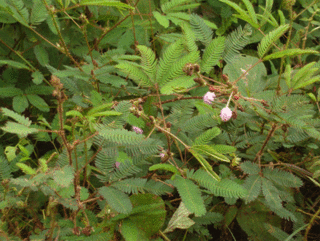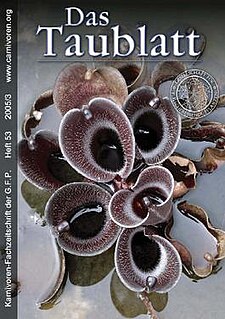
Droseraceae is a family of carnivorous flowering plants, also known as the sundew family. It consists of approximately 180 species in three extant genera. Representatives of the Droseraceae are found on all continents except Antarctica.

The Venus flytrap is a carnivorous plant native to subtropical wetlands on the East Coast of the United States in North Carolina and South Carolina. It catches its prey—chiefly insects and arachnids—with a trapping structure formed by the terminal portion of each of the plant's leaves, which is triggered by tiny hairs on their inner surfaces.
A calcifuge is a plant that does not tolerate alkaline (basic) soil. The word is derived from the Latin 'to flee from chalk'. These plants are also described as ericaceous, as the prototypical calcifuge is the genus Erica (heaths). It is not the presence of carbonate or hydroxide ions per se that these plants cannot tolerate, but the fact that under alkaline conditions, iron becomes less soluble. Consequently, calcifuges grown on alkaline soils often develop the symptoms of iron deficiency, i.e. interveinal chlorosis of new growth. There are many horticultural plants which are calcifuges, most of which require an 'ericaceous' compost with a low pH, composed principally of Sphagnum moss peat.

Drosera regia, commonly known as the king sundew, is a carnivorous plant in the sundew genus Drosera that is endemic to a single valley in South Africa. The genus name Drosera comes from the Greek word droseros, meaning "dew-covered". The specific epithet regia is derived from the Latin for "royal", a reference to the "striking appearance" of the species. Individual leaves can reach 70 cm (28 in) in length. It has many unusual relict characteristics not found in most other Drosera species, including woody rhizomes, operculate pollen, and the lack of circinate vernation in scape growth. All of these factors, combined with molecular data from phylogenetic analysis, contribute to the evidence that D. regia possesses some of the most ancient characteristics within the genus. Some of these are shared with the related Venus flytrap (Dionaea muscipula), which suggests a close evolutionary relationship.
Pyrophytes are plants which have adapted to tolerate fire.

Aldrovanda is a genus of carnivorous plants encompassing one extant species and numerous extinct taxa. The genus is named in honor of the Italian naturalist Ulisse Aldrovandi, the founder of the Botanical Garden of Bologna, Orto Botanico dell'Università di Bologna. Aldrovanda vesiculosa has been reported from scattered locations in Europe, Asia, Africa, and Australia.

Thigmonasty or seismonasty is the nastic response of a plant or fungus to touch or vibration. Conspicuous examples of thigmonasty include many species in the leguminous subfamily Mimosoideae, active carnivorous plants such as Dionaea and a wide range of pollination mechanisms.

A bog garden employs permanently moist soil to create a habitat for plants and creatures which thrive in such conditions. It may exploit existing poor drainage in the garden, or it may be artificially created using pond liners or other materials to trap water in the area. Any such structure must allow a small amount of seepage to prevent the water stagnating. For instance, a pond liner must be pierced a few times. Typically a bog garden consists of a shallow area adjoining a pond or other water feature, but care must be taken to prevent water draining from a higher to a lower level. The minimum sustainable depth is 40–45 cm (16–18 in). Good drainage is provided by gravel placed over the liner, and the bog can be kept watered by using a perforated hose below the surface.

A Pocosin is a type of palustrine wetland with deep, acidic, sandy, peat soils. Groundwater saturates the soil except during brief seasonal dry spells and during prolonged droughts. Pocosin soils are nutrient-deficient (oligotrophic), especially in phosphorus.

Arthur Dobbs was a British colonial official who served as the seventh governor of North Carolina from 1754 until his death in 1765.

John Ellis aka Jean Ellis was a British linen merchant and naturalist. Ellis was the first to have a published written description of the Venus flytrap and its botanical name. The standard author abbreviation J.Ellis is used to indicate this person as the author when citing a botanical name.

Pameridea is a genus of insects comprising two species, P. roridulae and P. marlothii, that live in symbiotic relationships with carnivorous plants in the genus Roridula. Pameridea marlothii only occurs on R. dentata, while P. roridulae exists on both R. dentata and R. gorgonias.
The Venus flytrap is a carnivorous plant.
Dionaea muscipula 'Bohemian Garnet' is a cultivar of Dionaea muscipula, the Venus flytrap. It is an F2 cross between Dionaea 'Royal Red' and Dionaea 'Sawtooth' that was published in the September 2007 issue of the Carnivorous Plant Newsletter. In the description of this cultivar, Miroslav Srba noted that it maintains the red coloration of the 'Royal Red' cultivar and most morphological characteristics of 'Sawtooth'. Srba also detailed the smaller size at just 4-6 cm across and the production of many offshoots as novel characteristics that warrant cultivar status. The cultivar name was coined by Srba to honor the country of origin, the Czech Republic (Bohemia), and can be written as Dionaea 'Český Granát'.
Nepenthesin is an aspartic protease of plant origin that has so far been identified in the pitcher secretions of Nepenthes and in the leaves of Drosera peltata. It is similar to pepsin, but differs in that it also cleaves on either side of Asp residues and at Lys┼Arg. While more pH and temperature stable than porcine pepsin A, it is considerably less stable in urea or guanidine hydrochloride. It is the only known protein with such a stability profile.
Dionaea muscipula 'Wacky Traps' is a cultivar of Dionaea muscipula, the Venus flytrap. Dionaea muscipula 'Wacky Traps' was a clone produced by Cresco Nursery in the Netherlands through tissue culture. This particular clone was discovered in a tray of a bunch of mutants by Mike Ross. It has also been called "Bart Simpson," coined by Ed Read, because of the resemblance of the plant to the animated character's spiky hair. The plant is an extremely slow grower. It has abnormally thick traps and petioles, which are probably the reason why 'Wacky Traps' has trouble closing its traps quickly. It takes several minutes trap closure even with repeated teasing of the trigger hairs.
Dionaea muscipula 'Fused Tooth' is a cultivar of Dionaea muscipula, the Venus flytrap. It has webbed teeth that appear in the summer.

Das Taublatt is a triannual German-language periodical based in Bochum and the official publication of Gesellschaft für fleischfressende Pflanzen im deutschsprachigen Raum, a carnivorous plant society based in Germany. Typical articles include matters of horticultural interest, field reports, and new taxon descriptions. The journal was established in 1984. It publishes in full colour on glossy paper, with each issue numbering around 52 pages.

Hippasteria muscipula is one of twelve species of deep-sea sea star in the genus Hippasteria, which is in the family Goniasteridae.












